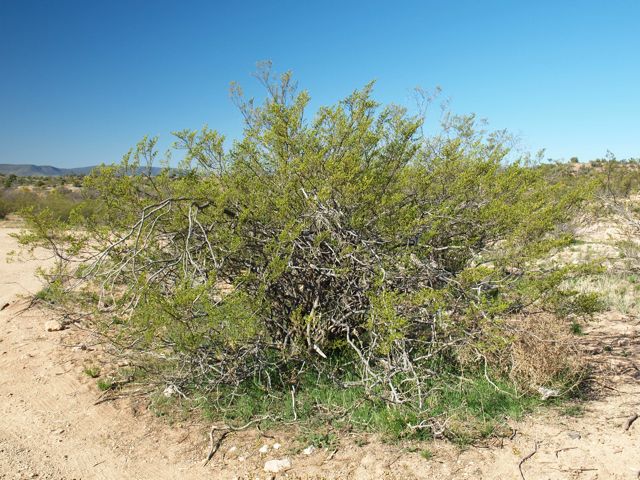 The Creosote Bush - October 11, 2017 Jeff Schalau, Agent, Agriculture & Natural Resources University of Arizona Cooperative Extension, Yavapai County Arizona is unique to other states in its varied landscape, animal life, and plant diversity, The Saguaro is certainly our state’s iconic plant, but the creosote bush is probably the toughest and most adaptable. Creosote bush also has several notable qualities and traditional/medicinal uses. Creosote bush (Larrea tridentata), sometimes called greasewood, is a large shrub found in most of Arizona’s counties. Creosote bush grows at elevations of 5,000 feet or lower and occupies thousands of square miles of Arizona’s Sonoran Desert. It is also common in the Mohave Desert in California, Nevada, and southern Utah as well as the Chihuahuan Desert of New Mexico, west Texas, and Mexico. Locally, creosote bush grows on valley bottoms and benches in and around the Verde Valley. Creosote bush blooms most profusely in the spring, but can have flowers at many times of year. The flowers are yellow and have five-petals. Following pollination, the flower petals twist 90 degrees. The leaves are small and coated with natural oils and wax to conserve water by limiting transpiration (the natural loss of water through leaves of plants). During dry periods, creosote leaves fold in half to cut their exposure to the sun. During severe drought periods, the creosote bush drops its leaves entirely and remains somewhat dormant until adequate precipitation arrives. Seed is produced in fuzzy, pea-sized capsules. These can be germinated by placing them in a shallow pan and covering them with boiling water. Soak overnight, then sow them several (5-7) seeds to a pot. Thin the seedlings to one per pot and grow them until they develop enough roots to hold the soil together. They should be planted directly into loosened native soil and occasionally irrigated for one or two years until they become established. Once established, irrigation can be reduced and eventually eliminated. Creosote bush’s drought tolerant qualities make it an excellent choice for xeriscape areas. Creosote bush has a strong characteristic odor which is especially noticeable when the foliage is wet. This creates the signature smell of a desert rain which should automatically trigger feeling of euphoria in any Arizona resident. The chemicals in creosote bush can sometimes trigger allergic reactions in some people. Farmers and ranchers often cuss creosote bush because it exudes growth inhibiting (allelopathic) compounds into the soil. It can also be poisonous to livestock that are naïve enough to eat large quantities of it. However, poor palatability usually prevents animals from browsing it. Individual creosote bushes can live to be about a hundred years old, but it can produce "clones" of itself through a system whereby the inner stems die and new stems appear on the periphery. This produces a circular pattern of genetically-identical plants, with the rings expanding outward about a meter every 500 years. The most notable creosote bush clone is called "King Clone" located on BLM land near Victorville, California. It is estimated at 11,700 years old and some scientists consider this to be the oldest living thing on earth. Creosote bush was used by indigenous people for fixing arrow points and mending pottery. Ethnobotanist, Gary Paul Nabhan, wrote the book Gathering the Desert. In it, he describes creosote bush as nature’s drugstore. In his research, Nabhan found that creosote bush has also been used by indigenous people for the treatment of at least fourteen afflictions and diseases: colds, chest infections or lung congestion, intestinal discomfort, stomach cramps associated with delayed menstruation, consumption, cancer, nausea, wounds, poisons, swollen limbs due to poor circulation, dandruff, body odor, distemper, and postnasal drip. Creosote bush does have antimicrobial properties and has been used to create topical ointments and salves to treat cuts and burns. These are sometimes available from herbal apothecaries and recipes abound on the Internet. Some references have recipes for creosote bush tea which is reportedly very bitter. I do not recommend taking it internally without consulting a physician. Creosote bush’s pharmacology is not well understood and some studies suggest it can cause liver and kidney damage. As a public servant, I always exercise caution when recommending natural remedies and edible plants. People may misidentify medicinal plants, use them inappropriately, or simply have an adverse reaction due to allergies or individual differences in physiology. Below is additional information about the botany, morphology, and ecology of the creosote bush. Follow the Backyard Gardener on Twitter – use the link on the BYG website. If you have other gardening questions, call the Master Gardener help line in the Camp Verde office at 928-554-8992 or e-mail us at verdevalleymg@gmail.com and be sure to include your name, address and phone number. Find past Backyard Gardener columns or provide feedback at the Backyard Gardener web site: http://cals.arizona.edu/yavapai/anr/hort/byg/. Photos  Creosote bush (Larrea tridentata, Sue Smith, Photographer).
Creosote bush (Larrea tridentata, Sue Smith, Photographer).Additional Resources Creosote Bush (from Yavapai County Native and Naturalized Plants) University of Arizona Cooperative Extension, Yavapai County cals.arizona.edu/yavapaiplants/SpeciesDetail.php?genus=Larrea&species=tridentata |